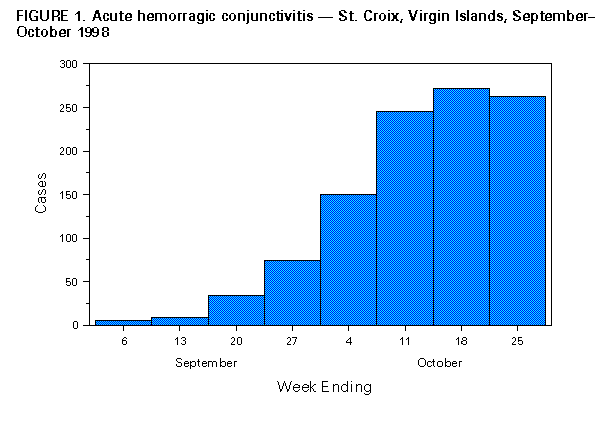 |
|
|
|
|
|
|
| ||||||||||
|
|
|
|
|
|
|
||||
| ||||||||||
|
|
|
|
|
Persons using assistive technology might not be able to fully access information in this file. For assistance, please send e-mail to: mmwrq@cdc.gov. Type 508 Accommodation and the title of the report in the subject line of e-mail. Acute Hemorrhagic Conjunctivitis -- St. Croix, U.S. Virgin Islands, September-October 1998Hurricane Georges struck the U.S. Virgin Islands on September 21, 1998. Immediately thereafter, health authorities on St. Croix (1998 population: approximately 50,000) became aware of increased numbers of cases of conjunctivitis. During September, one of the two public health clinics on the island recorded 88 cases of conjunctivitis, compared with three cases during August. Cases were characterized by periorbital swelling, excessive lacrimation, conjunctival redness with occasional hemorrhages, and foreign-body sensation in the eye. No severe sequelae were reported. Local ophthalmologists considered the symptoms characteristic of viral acute hemorrhagic conjunctivitis (AHC). This report describes the initial findings of an ongoing clinical, epidemiologic, and laboratory investigation of this outbreak. To identify cases, investigators reviewed medical records at the two Virgin Islands Department of Health clinics and the emergency department of the hospital in St. Croix. A case was defined as physician-diagnosed conjunctivitis since August 31. The number of cases increased substantially in early September before the hurricane, then plateaued during the following weeks (Figure_1). As of October 25, 1051 cases had been identified at these three facilities. Median age of 260 of the initial 273 AHC patients was 13.5 years (range: 3.5 months-81 years); 57 (22%) were aged 0-5 years, 99 (38%) were aged 6-17 years, and 104 (40%) were aged greater than or equal to 18 years. Sex distribution differed by age group; 78 (50%) of children were female, compared with 84 (78%) of adults who were female. Bilateral ocular involvement was reported among 116 (69%) cases. To further assess disease burden, investigators contacted approximately 600 households during October 17-21 by calling randomly selected listed telephone numbers. One adult in each household was asked whether any members of the household had developed conjunctivitis (defined as the onset of redness, tearing, swelling, itching, and/or burning around one or both eyes of at least 1 day's duration) within the preceding 8 weeks. Approximately 10% of households reported at least one case of conjunctivitis, and cases were distributed widely across the island. The self-reported average duration of symptoms was 5 days. Preliminary results from testing of laboratory specimens from St. Croix indicate that the probable agent is coxsackievirus A24 variant (CA24v). Control measures included disseminating public health information by press release and radio interviews and distribution of fact sheets by physicians' offices, public health clinics, and schools. St. Croix health authorities recommended that residents avoid social contact with persons who have AHC, including indirect contact (e.g., sharing towels or beds), restrict persons with AHC from attending school and work while symptomatic, and increase handwashing. Reported by: J Poblete, MD, A Bermudez-Walcott, MPH, V Ebbesen-Fludd, MS, J Heyliger, MPH, A Hatcher, US Virgin Islands Dept of Health. Health Studies Br, Div of Environmental Hazards and Health Effects, National Center for Environmental Health; Respiratory and Enteric Viruses Br; Div of Viral and Rickettsial Diseases, National Center for Infectious Diseases; and EIS officers, CDC. Editorial NoteEditorial Note: Preliminary results from this ongoing investigation document that an outbreak of AHC occurred in St. Croix during September-October 1998. The role, if any, of Hurricane Georges in the outbreak is under investigation. Outbreaks of AHC are characterized by high communicability, a short incubation period (1-2 days), and high secondary attack rates within households (1). Some outbreaks have been associated with rapid and efficient transmission, affecting greater than or equal to 50% of persons in communities within a 1-2-month period. Spread of the virus appears to be related to crowding and poor hygiene and is thought to occur primarily by person-to-person contact or contact with fomites (e.g., contaminated towels). Recovery is most often complete within 7 days, and complications, such as neurologic syndromes, related to the virus are extremely rare. Efforts to prevent AHC are particularly important because no effective treatment exists. Epidemics of AHC began in 1969 in Africa and are primarily caused by enterovirus 70 (EV70) and CA24v. These viruses have caused pandemics of AHC in tropical coastal regions throughout the world (1). Outbreaks of AHC have occurred periodically in the Caribbean beginning with EV70 in 1981 and CA24v in 1986 (2-5). During 1997, cases of AHC caused by CA24v were reported from several countries in Latin America (CDC, unpublished data, 1997). During September 12-October 17, AHC has been reported from several locations throughout the Caribbean region, including Antigua/Barbuda, Bahamas, British Virgin Islands, St. Christopher/Nevis, and Trinidad and Tobago (Caribbean Epidemiology Center, personal communication, 1998). CA24v has been identified from clinical isolates received from Suriname. Other countries in the Caribbean region could be affected during the current outbreak of CA24v-associated AHC. References
Figure_1  Return to top. Disclaimer All MMWR HTML versions of articles are electronic conversions from ASCII text into HTML. This conversion may have resulted in character translation or format errors in the HTML version. Users should not rely on this HTML document, but are referred to the electronic PDF version and/or the original MMWR paper copy for the official text, figures, and tables. An original paper copy of this issue can be obtained from the Superintendent of Documents, U.S. Government Printing Office (GPO), Washington, DC 20402-9371; telephone: (202) 512-1800. Contact GPO for current prices. **Questions or messages regarding errors in formatting should be addressed to mmwrq@cdc.gov.Page converted: 11/10/98 |
|||||||||
This page last reviewed 5/2/01
|